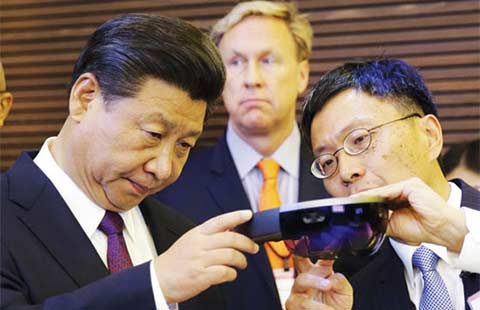Brickyard digs into ancient burial site for material
By Ma Lie in Xi'an (China Daily) Updated: 2015-12-18 08:29An inspection was launched by archaeological authorities into a claim that an ancient tomb was threatened by the operations of a nearby brickyard in Xianyang, Shaanxi province.
A micro-blogger using the name Zhang Chi, a heritage enthusiast in Beijing, raised the issue with a satellite photo that appeared to show that the brickyard was getting material for production in the cemetery of the ancient tomb.
In the photo caption, Zhang said the cemetery of Emperor Yuandi was being nibbled away.
The cemetery of Emperor Yuandi, or Liu Shi (74-33 BC), the 11th emperor of the Western Han Dynasty (206 BC-AD 24), is located in a northeastern suburb of the city and was listed as a State-level protected heritage unit in 2001 by the State Council.
The photo caught the attention of the Xianyang Heritage and Tourism Bureau, which sent an inspection team to investigate.
According to Si Xichang, captain of the city's Weicheng district heritage inspection team, he and some colleagues went to the brickyard on June 24 and found that workers had taken earth from as far as 20 meters inside the cemetery boundary, and they ordered it to stop.

The brickyard, southwest of the cemetery, belongs to Zhouling New Building Materials Co, a township enterprise established in 1970 that was believed to be the largest brick producer in the city.
Si Lingke, chairman of the enterprise, said the factory had approval from the local land and resources bureau, and the excavation was within the scope of the approved plan.
On Dec 7, Zhang, the blogger, posted another satellite photo that purports to show that the brick factory took some 1,000 cubic meters of earth from the cemetery in the past month.
Officials from the city's land and resources bureau, the environmental protection bureau and the heritage bureau went the factory again on Dec 9 and said they found new earth that was traced to the cemetery. The factory said the new traces were from landslides caused by local farm irrigation.
The factory was ordered to stop taking earth from the cemetery. Meanwhile, the land and resources bureau will redefine the limits of excavation.
Heritage experts in the city said a key reason the cemetery was threatened was that the boundaries were approximate, not exact.
"If the brickyard were to close, many local residents would lose their jobs," said Lei Yiqun, a heritage expert at Xianyang Normal College. The contradiction between the economy and heritage protection should be resolved by reasonable delineation of development boundaries and the industrial layout, Lei said.
- Physicists on cutting edge in search for dark matter
- Top information office holds record number of news conferences
- Shenzhen leaps to top of efficiency list in 2 yrs
- China aims to expand global FTA network
- Year's worst smog coming to north China
- China launches satellite to shed light on invisible dark matter
- China strongly opposes US arms sale to Taiwan
- Report: Layoffs may loom next year
- Pandas prefer choosing their own sex partners, researchers find
- Cyberspace door stays open, says watchdog chief







